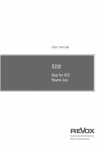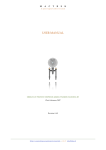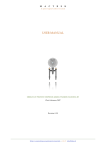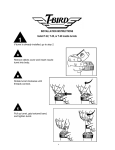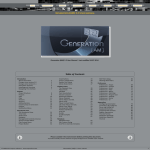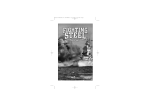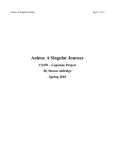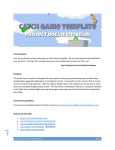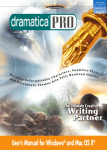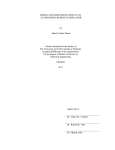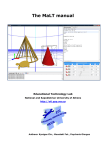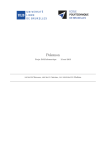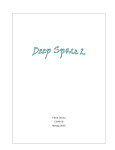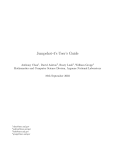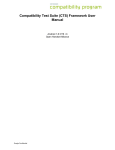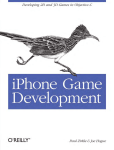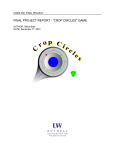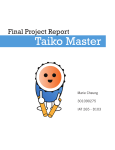Download Final Report and Manuel
Transcript
Software Design Game Design Documentation Cataclysmic Cosmos Robert Lockyer and Andrew Carter 4/3/2009 Table of Contents Introduction ......................................................................................................................................... 1 Use Cases ............................................................................................................................................ 2 Start-up ............................................................................................................................................ 2 Player Ship Movement ..................................................................................................................... 3 Placing a Turret ................................................................................................................................ 4 Move Turret ..................................................................................................................................... 5 Enemy “Dive Bomber” Ship attack .................................................................................................. 6 Plasma Turret Attack ........................................................................................................................ 7 Design Outline ..................................................................................................................................... 8 Package Level Design ........................................................................................................................ 10 Class Level Design ............................................................................................................................ 13 Game Manager ............................................................................................................................... 13 ViewMgr ........................................................................................................................................ 13 Vector2........................................................................................................................................... 13 GameState...................................................................................................................................... 13 PlayViewMgr ................................................................................................................................. 13 PlayState ........................................................................................................................................ 13 Key Interfaces .................................................................................................................................... 14 User Manual ...................................................................................................................................... 15 Movement ...................................................................................................................................... 15 Turret Placement ............................................................................................................................ 16 Turret Movement ........................................................................................................................... 17 Other Controls................................................................................................................................ 17 Game Mechanics ............................................................................................................................ 18 Enemies ......................................................................................................................................... 18 Conclusion ......................................................................................................................................... 19 [CATACLYSMIC COSMOS: DESIGN] [April 3rd 2009] Introduction Cataclysmic Cosmos is an original game inspired by games of the tower defence genre as well as classic arcade games like asteroids. The game revolves around a single spaceship that is controlled by the player. It is the player‟s task to defend a planet from incoming waves of enemy ships. The player cannot attack directly, his ship is unarmed. However, he can build and relocate various types of turrets around the planet. These turrets will automatically orbit around the planet. This orbiting system is one of the main differences between Cataclysmic Cosmos and other tower defence games. Figure 1 shows same initial concept art created in order to help illustrate game play mechanics. Figure 1: Initial Concept Art [Robert Lockyer and Andrew Carter] | Introduction 1 [CATACLYSMIC COSMOS: DESIGN] [April 3rd 2009] Use Cases Start-up Use Case “Game Start-up” Subject Cataclysmic Cosmos Goal To Start the Game Actors The Player, The Operating System Precondition The Player is interacting with an OS which has JRE 1.5.0 or greater installed Steps Post Condition Alternative Paths 1. 2. 3. 4. 5. The player requests that the OS start the Game. The OS starts the JVM, which launches the Game. Game shows the player an intro screen The player presses the spacebar The Game draws its playing field and the game starts running “The Game is Started” 1. After Step #3: If the player presses the „Esc‟ Key or clicks the close button inherent to the application window the game terminates with post condition “Game Terminated” 2. After Step #3: If the player presses H in the intro screen they are taken to a help screen, from there the player can return to step 3 (the intro screen) by pressing BACKSPACE [Robert Lockyer and Andrew Carter] | Use Cases 2 [CATACLYSMIC COSMOS: DESIGN] [April 3rd 2009] Player Ship Movement Use Case “Player Ship Movement” Subject Cataclysmic Cosmos Goal To Manoeuvre the Player Ship in the Game World Actors The Player Precondition “The Game is Started” Steps Post Condition Alternative Paths 1. The player presses a keyboard key(s) associated with a movement direction – „W‟ for Forwards, „S‟ for Backwards. „D‟ for Yaw clockwise, „A‟ for Yaw counter-clockwise. 2. The player begins, and continues to move in the direction(s) specified until the key(s) is released 3. The player ship continues moving along the current velocity vector “The Game is Started” 1. The ship reaches the edge of the screen. It is instantly transported to the opposite edge. [Robert Lockyer and Andrew Carter] | Use Cases 3 [CATACLYSMIC COSMOS: DESIGN] [April 3rd 2009] Placing a Turret Use Case “Place Turret” Subject Cataclysmic Cosmos Goal To place a friendly turret in the game world Actors The Player Precondition “The Game is Started” Steps Post Condition Alternative Paths 1. The Player moves the player ship into an orbital zone 2. The Player presses a key corresponding to the type of turret he wishes to create – i.e. „T‟ for “plasma” turret type 3. The game checks to ensure that the player has enough money to create the desired turret 4. The turret is created and placed on the orbital path corresponding to the orbital zone the player ship is currently in “The Game is Started” and “At least one Turret is in play” 1. During Step #2: If the player tries to place a turret outside of an orbital zone the attempt fails and the use case terminates with post condition “The Game is Started” 2. During Step #3: If the player does not have enough money to create the desired turret then the game informs the player of this fact and the use case terminates with post condition “The Game is Started” [Robert Lockyer and Andrew Carter] | Use Cases 4 [CATACLYSMIC COSMOS: DESIGN] [April 3rd 2009] Move Turret Use Case “Move Turret” Subject Cataclysmic Cosmos Goal For the Player to Move a Friendly Turret Actors The Player Precondition “The Game is Started” and “At least one Turret is in play” Steps Post Condition Alternative Paths 1. The Player moves the player ship into the action range (defined radius) of a turret 2. The game provides visual confirmation that the player ship is within action range of a turret 3. The user presses the SPACEBAR to attach the turret to the player ship 4. The Turret stops its normal movement pattern and moves along with the player ship. It also stops its attack pattern 5. The player manoeuvres the ship to a location where he would like to place the turret (this location must be within an orbital zone) 6. The player presses the SPACEBAR to detach the turret 7. The turret begins moving along the orbital path associated with the zone the player ship is currently in “The game is started” and “At least one Turret is in play” 1. During Step #6: If the player ship is not currently located in an orbital zone then the key press does nothing. The use case continues at Step #6. [Robert Lockyer and Andrew Carter] | Use Cases 5 [CATACLYSMIC COSMOS: DESIGN] [April 3rd 2009] Enemy “Dive Bomber” Ship attack Use Case “Enemy Dive Bomber Ship Attack” Subject Cataclysmic Cosmos Goal For the enemy ship to attack the planet under defence Actors The Enemy Ship (AI) Precondition “The Game is Started” Steps Post Condition Alternative Paths 1. The game spawns a Dive Bomber ship on the perimeter of the game world 2. The Dive Bomber heads for the planet under defence along a straight line path 3. The Dive Bomber collides with the planet under defence and is destroyed, doing damage to the planet “The Game is Started” 1. During Step #2: If turrets placed by the player do enough damage to the Dive Bomber during its trip to the planet under defence, then the Dive Bomber is destroyed prematurely, doing no damage to the planet [Robert Lockyer and Andrew Carter] | 6 [CATACLYSMIC COSMOS: DESIGN] [April 3rd 2009] Plasma Turret Attack Use Case “Plasma Turret Attack” Subject Cataclysmic Cosmos Goal For the plasma turret to attack incoming enemy ships Actors The Plasma Turret (AI) Precondition “The Game is Started” Steps Post Condition Alternative Paths 1. An enemy ship enters the attack range of the turret 2. The turret fires a straight shot directly at the ship with enough velocity to make a direct hit, damaging the enemy vessel 3. The turret continues to take shots with a regular frequency until the enemy vessel leaves its attack range or is destroyed 4. The turret then chooses it‟s next target by evaluating which enemy ship is closest to it and in its attack range 5. If it finds a new target it continues from step# 2, else it stops firing “The Game is Started” 1. After Step # 1: If the player ship attaches the turret to itself then it stops firing. The use case ends with post condition “The Game is Started” [Robert Lockyer and Andrew Carter] | 7 [CATACLYSMIC COSMOS: DESIGN] [April 3rd 2009] Design Outline Our design is split into two main components, the model and view. The model holds onto all of the games state information. The view is dependent upon the model. This allows us to easily switch out the view if we ever decided to port the game to a new graphics API like Jmonkey. Another key aspect of our high level design is that we make use of the state pattern for controlling what the active scene is. This is useful because screens like the intro screen don‟t carry the extra baggage that a more complex scene like the playing scene has to deal with. We can develop these components in isolation and add new scenes with relative ease. Our implementation of the state pattern can be seen below (Figure 2). Figure 2: Model Package The way that the java Graphics2D object works required us to design our interactions between the model and view in a very specific manner. The Graphics2D object is only valid for the duration of [Robert Lockyer and Andrew Carter] | Design Outline 8 [CATACLYSMIC COSMOS: DESIGN] [April 3rd 2009] the paintComponent method this means that the view must call the model from this method in some way in order to fetch fresh information. Since the view knows the model it can do this with relative ease. The view is known by the model through a series of interfaces shown below. The GameManager only knows various views as GameViews. But the specific states know them as their more specific derived interfaces such as HelpView, IntroView etc. These are the interfaces in the middle of Figure 3. Figure 3: View Package [Robert Lockyer and Andrew Carter] | Design Outline 9 [CATACLYSMIC COSMOS: DESIGN] [April 3rd 2009] Package Level Design As stated in the design outline the project is split into two main packages. These are the model and view respectfully. The view is considerably simpler than the model and therefore is not further divided into smaller packages. However the model is much larger and complex and therefore requires the greater organisation and compartmentalization that packages provide. The model is highly dependent upon GameStates and therefore we have decided to group these into a package under the names of States. Figure 4:PlayStates Sub-Components [Robert Lockyer and Andrew Carter] | Package Level Design 10 [CATACLYSMIC COSMOS: DESIGN] [April 3rd 2009] The most complicated of these states is PlayState. The layout of classes used by this state actually dictates the organization of the remaining packages that have not been mentioned yet. Therefore to understand the layout of these packages it is important that one has some idea of how the PlayState is set up. Figure 4 shows the relationships of classes and interfaces related to the operation of PlayState. Figure 5:Projectiles Package There are three important hierarchies of classes which we have logically grouped into packages. These are projectiles, Turrets and Enemies. Each of these is derived from abstract classes of the same name and therefore they share much in common. Figure 5, Figure 6 and Figure 7 show how these packages are arranged. [Robert Lockyer and Andrew Carter] | Package Level Design 11 [CATACLYSMIC COSMOS: DESIGN] [April 3rd 2009] Figure 6:Turrets Package Figure 7: Enemies Package [Robert Lockyer and Andrew Carter] | Package Level Design 12 [CATACLYSMIC COSMOS: DESIGN] [April 3rd 2009] Class Level Design Game Manager Top Level Game Model Object. Controls Update call Percolation among other things. The GameManager class is concerned with keeping track of time and holding onto the current state of the game. To keep track of this information we've implemented the state pattern. The three states that are designed so far are the IntroState, PlayState, and ScoreBoardstate. These states require pointers back to the GameManager so they can change the state when required. ViewMgr An abstract class, which all view managers should extend. Used to collect the common functionality between view managers, which seems reasonable to generalize. Also useful as a means from which to implement polymorphic code. Vector2 A two dimensional, geometric Vector Allows for useful operations such as finding the distance between two points, getting an angle from a vector, performing dot products and more. Used extensively by PlayState components. GameState Acts as a state in the state pattern, The GameManager's state is controlled by what concrete GameState it holds at any given time. Swapping the old PlayState with a new one effectively resets. Other GameStates are included for an intro, scoreboard and help screen. PlayViewMgr Main View Component used to Visualize the Play State This JComponenet extends JPanel and implements PlayView. It is responsible for managing all the various view subcomponents for the Play State. In addition, by implementing GameView it is able to act as an ambassador to the model on behalf of the rest of the view. PlayState State Class which Orchestrates the cooperation of key gameplay objects Of the three main game states, the play state is by far the most significant. This is because it handles the core game logic. It creates different kinds of physical objects such as the playerShip, OrbitalZones and Planet and then specifies in its main loop when they should move along with some facets of how they should interact. For more information on classes please refer to the included javadoc. [Robert Lockyer and Andrew Carter] | Class Level Design 13 [CATACLYSMIC COSMOS: DESIGN] [April 3rd 2009] Key Interfaces Making the view depend upon the model required the creation of several interfaces that the view classes could inherit. Each game state was given a corresponding interface which was derived from the abstract class GameView seen below. This allowed the GameManager to know the view states in a general way while the specific GameStates could know more specific details about their functionality. Figure 8: PlayState PlayView Interaction Drawables were a useful interface for the PlayStates sub-components. Basically, they were a way of letting the model tell the graphics object how to draw those objects. For more information on interfaces please refer to the included javadoc. [Robert Lockyer and Andrew Carter] | Key Interfaces 14 [CATACLYSMIC COSMOS: DESIGN] [April 3rd 2009] User Manual Starting the game is as simple as double clicking the jar file. The player will be brought into an intro screen. From here they can either press the spacebar to start playing or press the H key in order to see a help screen (Figure 9). These options are displayed to the player so they won't need to read a manual in order to play. Figure 9: Help Screen Movement Controls W- Forward S – Reverse A – Rotate Counter Clockwise D – Rotate Clockwise The player is represented by a yellow construction ship; its movement is not restricted by friction. This means the player will maintain their velocity unless they use their engines to change it. If the player [Robert Lockyer and Andrew Carter] | User Manual 15 [CATACLYSMIC COSMOS: DESIGN] [April 3rd 2009] hits the edge of the screen they will be instantly transported to the other side. This can be a useful shortcut in some situations. Turret Placement Controls T – Lay Plasma Turret Y – Lay Shockwave Turret U – Lay Stasis Turret The idea of the game is to build and arrange turrets to defend the planet from incoming enemy ships. To build turrets the player must be within one of the four “orbital zones”. These zones are indicated by gray rings which surround the planet. If the player is inside a ring it will light up green to indicate this. Figure 10:Orbital Rings light up green when the player ship enters them Once the players inside of a ring he can place a turret by pressing the corresponding keys as shown in the controls guide. However, this will only work if the player has the money required to build the turret. If not those keys will result in no reaction. In the above figure if the player presses either T Y or U a turret will be created on the first level. [Robert Lockyer and Andrew Carter] | User Manual 16 [CATACLYSMIC COSMOS: DESIGN] [April 3rd 2009] Turret Movement Controls SPACEBAR – Grab a turret/Drop a turret Once turrets are placed they can be moved in order to take advantage of the bonuses from different rings. In order to do this the player must move close by a turret. Once they are in range the turret will light up to indicate that it is the active target. Pressing the spacebar at this point will grab the turret and lock it to the player‟s ship. Dropping the turret works much like placing one. You must be within a ring and pressing spacebar at this point will drop the turret there. No money will be spent to perform this action. Figure 11: The player ship is in range of a turret In the above figure (Figure 11) the player is within range of a turret. Pressing spacebar will attach it to the player‟s ship. There is a subtle glow effect on active turrets that shows up better during animation. Other Controls Controls ESC – Exit the game [Robert Lockyer and Andrew Carter] | User Manual 17 [CATACLYSMIC COSMOS: DESIGN] [April 3rd 2009] Game Mechanics There are a couple of game mechanics that are not immediately obvious and so will be explained here in order to help new players understand the game. Each turret has three different levels. These levels are indicated by differing graphical representations. These are shown below (Figure 12) for the stasis turret. The higher the level of the turret the more effective it will be. Level 1 Level 2 Level 3 Figure 12: Turret Levels There are four orbital rings within which the player‟s turrets can be placed. These rings incur bonuses to the turrets upgrade speed. The closer to the planet the faster the turret will be upgraded. Therefore it is often beneficial to place turrets close to the planet when first building them and then move them out as they reach level 3. The outside ring has the lowest experience bonus; however turrets in this ring get the most shots off since they are not blocked by the planet. Enemies There are currently three different enemy types. They are shown below (Figure 13). Their behaviours are generally related to their names. The slow tank is a slow moving unit which can take a lot of damage from turrets before being destroyed. It will approach the planet directly and begin firing on it when it gets within range. Slow Tank Cluster Kamikaze Figure 13: Enemy Types The Cluster enemy is designed to attack in swarms and is relatively weak. This makes Shockwave turrets ideal against them since they can destroy multiple in a single blast. Kamikaze enemies are somewhere in the middle ground in terms of health and speed. Unlike the other enemies these approach the planet and dive-bomb it dealing damage and destroying themselves in the process. [Robert Lockyer and Andrew Carter] | User Manual 18 [CATACLYSMIC COSMOS: DESIGN] [April 3rd 2009] Conclusion The model/view split of our system is a useful and flexible design. However, something about how we implemented it results in a disparity between model and view updates. We believe this is a result of the Jframe running in a different thread then the model. At first we were receiving a lot of exceptions related to multithreading. Placing synchronization blocks around some of our vectors of drawables resulted in eliminating these exceptions. However, it did not fix the root of the problem. There are still occasionally hiccups where one thread waits on the other. If we were given more time one of our first tasks would be investigating how this multithreading is operating and try and redesign our game to avoid or at least better control this issue. [Robert Lockyer and Andrew Carter] | Conclusion 19





















